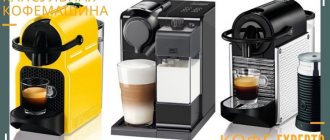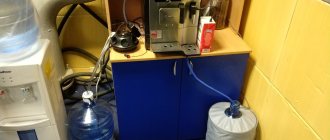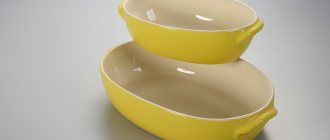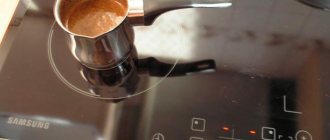Once upon a time, refrigerators were designed according to the principles of physics - heavy cold air fell down through the lattice shelves, lowering the temperature of the entire chamber. Today everything has become more complicated; not everyone understands where the coldest place in the refrigerator is.
The early principle of the refrigerator was to push heavy cold air down through lattice shelves, but now the shelves are glass and the circuit has become more complicated.
With the advent of two-chamber and three-chamber modifications, where the freezer is at the bottom and the shelves are glass, not every housewife is able to properly distribute food. The issue of storing food in the refrigerator should be given enough attention to extend the shelf life of food.
What determines the temperature distribution in the refrigerator?
When preparing food for use, it is important to know where the coldest places in the refrigerator are.
Many families have arguments about where it is colder in their refrigerator - at the top or bottom. There are no clear instructions on this topic in the instructions, and everyone arranges bags and pots at their own discretion. It is not customary for some owners to purchase a lot of food, and where the warmest and coldest places are is determined empirically. For those who make purchases for future use, this question is most relevant.
Regardless of the instructions on the packaging and the appearance of the products, it is important to follow the unshakable storage rule. It is not recommended to keep food in the refrigerator for more than 3 months, especially if it has been opened.
It is not always possible to determine whether the inside of a powerful unit is cool enough if its temperature is adjusted correctly. When the first dishes do not freeze on the top shelf, it seems that it is equally cold everywhere.
Always check the cold control settings.
On the other hand, constantly freezing food is the norm for some. In this way, they “expand” the capabilities of a crowded freezer, trying to store meat and fish on the coldest shelf at the back wall.
Meat and fish are stored on the coldest shelf against the wall.
A refrigerator filled to capacity not only prevents food from cooling properly. Energy consumption increases to maintain a given level - no higher than +4-5°C. Special sensors and relays are responsible for the temperature maintenance function. If the door is often opened and it takes a long time to choose what to eat, the cheeses and yoghurts standing on it will quickly become unusable.
A refrigerator that is overloaded with food will not be able to function fully.
Where in the refrigerator is it colder?
To avoid being mistaken about which shelf in your refrigerator is colder, it is important to find a source of low temperature. Cold and warmer locations may vary depending on the design and brand of unit. Visually, you can also determine where it is coldest - there is ice or artificial frost.
The location of cold and warmer shelves in the refrigerator depends on the brand and design of the refrigerator.
Inside an overloaded unit, full air circulation is disrupted, cold and warm air masses are poorly mixed.
Initially, the designers proposed placing the cold source at the top so that the heavy air would “flow” down. Modern units have partitions, valves and doors that can isolate the microclimate inside a small compartment. Therefore, the temperature in different places can vary by several degrees.
Warm air entering the refrigerator when the door is open changes the temperature in different zones differently.
Important nuances
Refrigerator manufacturers indicate operating temperature parameters in the equipment instructions. In the instructions you can find a note with cooling modes for each shelf or zone of the device. If the equipment works properly, then this data will be relevant throughout its entire service life. There is a possibility that after 5-8 years of operation, the modes may change in favor of increasing degrees. This occurs due to the gradual evaporation of freon or due to its leakage through leaky joints.
You can check the temperature yourself if you have a room thermometer at hand. Leave it for 10 minutes on each shelf to get accurate readings. After the measurement, you need to remove it from the refrigerator and let it recover indoors in order to get accurate data the next time you take it. Products must be distributed in accordance with the information received, taking into account that some of them can be frozen, others require refrigeration, and others require a low positive temperature.
The temperature on the door shelf is highest, and this rule applies to equipment with any model of cooling mechanism. There are no freon circuits installed in the door, and when opened, the door is in contact with the room temperature.
The refrigerator door is the warmest place, regardless of its design.
By knowing the exact temperature distribution inside the refrigerator, you can achieve better preservation of food for a long time. Avoid premature equipment failure due to operation under increased loads.
Single chamber refrigeration units
A characteristic feature of single-chamber models remains the location of the freezer. It is located in the upper part of the common chamber, therefore, it is coldest on the adjacent shelves. The subzero temperature separation evaporator produces cold.
In single-compartment refrigerator-freezers, the coldest places are on the shelf under the freezer.
There are also single-chamber chest freezers used for transporting and selling products. For some time, small refrigerators without a freezer were also produced, in which the cooling was from the rear wall. The temperature there is approximately the same, but it is not recommended to store food there for a long time.
In refrigerators without a freezer, the coldest places are near the back wall.
The unique design of a refrigerator with one chamber
The simplest device is found in old single-chamber models. They are distinguished by lattice shelves and the proximity of the common space to the freezer. The upper part is always colder; perishable foods should be stored here.
The simplest device is equipped with old single-chamber refrigerators.
However, if we consider different models, their temperature conditions may differ significantly. This largely depends on the material of the shelves and the overall occupancy of the space. Solid surfaces made of glass and plastic inhibit the spread of cold.
Which shelves are the coldest in single-chamber refrigerators?
The coldest place is at the top, where the cooling source is located. It is better to lay out meat products, fish and semi-finished products here.
In single-chamber refrigerators, the top shelves are colder.
In the lower part, where it is warmest, there may be vegetables and fruits that spoil from hypothermia. The sign is red spots; pathological microflora often develops in these places.
You should not risk the health of your household. It is better to dispose of vegetables, mushrooms and fruits if they are expired or have signs of rot. They can be a source of mold and mildew for safer food.
Review your inventory as often as possible. It is advisable to cook products with signs of damage as quickly as possible, cutting off areas with flaws.
Single-compartment refrigerator without freezer - the main characteristics of compact household appliances
Many people imagine a standard single-compartment refrigerator without a freezer as a tiny box into which you can squeeze several kilograms of food. This statement is incorrect, because modern devices are very different in design, can be built into a headset, have different dimensions, and a lot of other advantages.
Double chamber refrigeration units
Of course, the invention of two-chamber refrigerators was a new breakthrough in this niche of kitchen equipment. Having such a unit, you don’t have to worry about the food above freezing. Or that food will spoil if placed on the wrong shelf.
The invention of two-chamber refrigerators greatly improved food storage.
The only caveat is that the door is often opened, a place where you should not put perishable food. It is warmest here, since the “microclimate” is unstable, however, as in single-chamber models. When opened, the delicate temperature balance is reset, so you can only put fresh herbs, eggs, hermetically sealed sauces and drinks here.
The unique design of a refrigerator with two chambers
In modern two-chamber models, everything is thought out to the smallest detail. The freezer and the common chamber function separately; each part has its own evaporator, which provides the necessary cold.
A two-chamber refrigerator is a complex system where conditions are created for the best preservation of food.
The coldest place is at the back wall, near the evaporator holes.
Unlike single-chamber options, the lower part of the compartments is also cold, since the heavy air mass falls down unhindered.
Which shelves are the coldest in two-chamber refrigerators?
New models with forced convection ensure uniform circulation of cool currents. All compartments, even in a crowded refrigerator, will have the same temperature. But it is worth taking into account that during such storage, products quickly lose moisture. They should only be stored in airtight packaging or tightly sealed containers.
One great option for storing food is tightly sealed containers.
If we talk about the freezer, then everything is ambiguous here too. It is warmer on the top shelf than below, within 10 – 14°C below zero. Frozen fruits and berries, mushrooms and seafood are placed here.
Fish is stored on the coldest shelf.
The coldest shelf is located at the bottom, this is the place for cutting meat, offal, fish and poultry carcasses.
Useful and useless options
Sales consultants in stores talk little about the basic parameters of equipment, but enthusiastically talk about additional ones. They try to convince us that without such and such a sensor or sensor, the device is simply useless. This is no coincidence.
Additional features make the refrigerator more expensive.
Let's figure out what bells and whistles are in refrigerators and which of them are really useful.
- Antibacterial coating . The walls of the refrigerator compartment are coated with silver ions, which prevent the growth of bacteria. It seems like a marketing gimmick: if you keep your refrigerator clean, you don't need any ions.
- Carbon filter . It circulates air inside the refrigerator compartment and absorbs unpleasant odors (not to be confused with individual flavors). It is not required if you do not allow products to stagnate and place strong-smelling products in containers.
- Door open indicator . If it is not closed or not closed tightly, an audible signal will sound. Useful if there are children or elderly people in the house who often carelessly slam the refrigerator.
- Autonomous cold storage . When the lights are turned off, the food remains fresh for a long time. Useful if there are frequent power outages in the region.
- Super freezing . This is a mode in which the temperature in the freezer briefly drops to –24–28 °C. The advertisement says that quick freezing allows you to preserve the maximum amount of useful components in products. In fact, it just saves time. There is a similar function for refrigerators: you can quickly cool a bottle of wine.
- Cold water supply . In budget models, it is implemented like this: water is manually poured into a special reservoir in the door and cooled permanently. So all this can easily be replaced with a regular jug of water in the refrigerator. In premium models, water is supplied directly from the water supply. But it's much more expensive.
- Ice maker . Water can also be filled into the ice cells manually or automatically. This also affects the price. But first of all, you need to understand how often you freeze ice for drinks and whether you can get by with ordinary silicone molds in the freezer.
Rules for storing food in the refrigerator
In the main compartment there are several shelves where everything is usually stored, complicating natural convection - the cold sinks down, displacing warmer air.
Tightly packed foods do not allow air to circulate.
Bags and containers should not be folded tightly; there should be gaps between them for cool circulation.
Storing products in the positive chamber, where the temperature is set by a relay regulator from 0 to +5°, has its own characteristics.
Storing food in the refrigerator at temperatures from 0 to +5°.
The coldest place is on the plane adjacent to the freezer or on the back wall. It is correct to put meat products away, especially if it is chilled chicken stored without freezing. As a rule, it is prepared within 3 days.
Non-frozen chicken is stored at the back wall.
You cannot place cheese, cold cuts and dairy products on the same shelf with meat. The exception is properly packaged food - in tightly closed containers, containers and sealed bags. Milk, meat and fish dishes are also stored on the coolest shelves.
Dairy products are stored on cooler shelves.
Greens, vegetables and fruits are often stored in the lower compartment, but they need to be laid out separately. The unpleasant onion smell can make bananas or apricots unpleasant, especially for children. If there are few vegetables in the apartment, and you intend to cook them soon, it is better to keep them in nets on the balcony or in a cool pantry, away from shelves with perishable foods.
Vegetables stored in the refrigerator stay fresh longer.
How to measure temperature level
In old-style refrigerators, all indicators are displayed using mechanical sliders. For accurate measurements, you must use a thermometer, which is placed on a dry dish inside the chamber for 8-10 minutes.
Modern models of technology have electronic sensors for accurately calculating all important parameters. The necessary information is displayed on a convenient external display.
Thermometer for measuring temperature. But it's better to put it on a saucer
Tips for properly storing food in the refrigerator
Odors in any refrigerator compartment tend to mix. Food that has been stored for a long time does not smell like fresh food. Expired products do not always “signal” with a smell, but pathogenic microflora is already beginning to develop.
Always make sure there are no expired foods in the refrigerator.
Review products with expiration dates frequently.
Pears and apples, if there are only a few of them, should not be placed in the refrigerator. It is suggested that the fruits be washed and displayed in a vase (on a tray) in the living room or on the dining table. Peaches, apricots, plums and grapes are best stored on the warmest shelves of the refrigerator.
Fruit is stored on the warmest shelves of the refrigerator.
Zucchini and squash, watermelons and melons, and other melons can be stored for up to a week outside the refrigerator, and they can be cooled before slicing. Mushrooms and such “capricious” vegetables as cucumbers, tomatoes, eggplants and bell peppers need refrigerated storage. But even when frozen, they also spoil, so you can’t put them on top of cold shelves near the freezer.
Vegetables should be stored refrigerated.
In places with a “temperate climate” with temperatures from +3 to +6°C, you can safely leave pots with first and second courses, a bowl of jellied meat. Nearby there may be butter and lard, smoked meats, cheeses and sweets, open preserves and sausages.
Sausages and smoked meats can be stored at temperatures from +3 to +6°C.
General advice from nutritionists and naturopaths is that if you live near a supermarket, do not stock up on a lot of food for future use. On the way home from work, it is better to buy dairy products and semi-finished products, sliced and fresh herbs for 1-2 days.
If possible, it is better to purchase products for 1 - 2 days.
Many dishes, including cottage cheese and meat products, do not require long-term storage. No matter where they are placed, they have a short shelf life - no more than 3 days. Cold shelves, foil, parchment paper and polyethylene will not protect perishable food from the development of pathogenic microflora.











